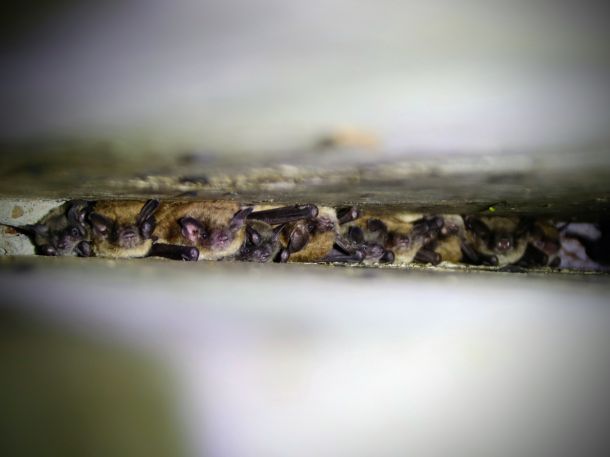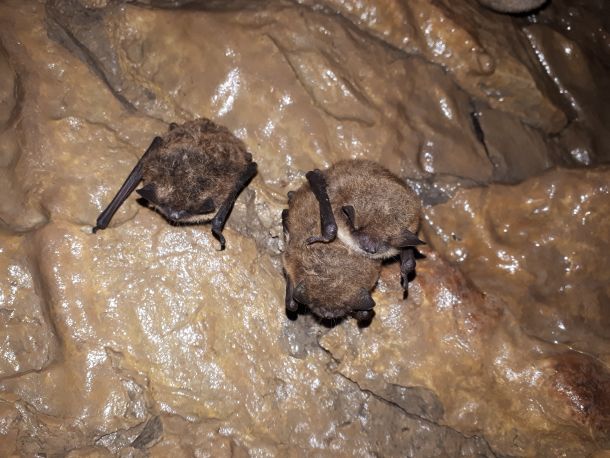This piece comes to us from Wildlife Conservation Society (WCS) in honor of Bat Week.

Most bats using bridges during the day are well-hidden high above your head, silently looking down on interlopers passing below. Photo credit: Cory Olson/WCS Canada.
How many bridges have you driven over without giving a single thought to what is going on underneath? You might be surprised by what is happening down there.
The thousands of bridges that are laced across our landscape transect some of the most biodiverse habitats around, particularly rich river valleys. Many bats rely on rivers as movement corridors in spring and late summer and these rivers also provide the habitat needed for feeding and accessing water. That means that bridges crossing rivers and creeks provide an ideal location for bats and bat biologists to come together.
That bats use bridges is no surprise given how well our only flying mammal has taken to human infrastructure like buildings. Just check videos of the million-plus aggregation of Mexican Free-tailed Bats pouring from Austin, Texas’s Congress Avenue Bridge at sunset. But until we began our study of bridges last year, we had no idea if bats in Canada used them more than occasionally.

Concrete bridges absorb heat from the sun during the day that is slowly released over the night, allowing bats to stay warm. Photo credit: Cory Olson/WCS Canada.
Most bats using bridges during the day are well-hidden high above your head, silently looking down on interlopers passing below. To avoid being picked off by predators like crows and ravens, they roost in the narrow cracks and crevices of the bridge—until sunset. However, bats have an easy “tell.” Their insatiable appetite (they can eat their own body weight in insects each night) means that they poop a lot! Bat poop, known as guano, is the key to our study.
But why would we want to collect bat guano? Have bat biologists “guano” crazy? Well, that guano contains bat DNA and the DNA of their prey. It also contains traces of pathogens and environmental contaminants, making it well-suited for monitoring the health of bat populations. Even hormone levels can be measured from guano, opening the door to examining the stress levels of bats in different environments.
In 2021 and 2022, with the help of numerous volunteers and partners, we surveyed nearly 800 bridges across western Canada, from Saskatchewan to British Columbia to the Northwest Territories. As cars and trucks rumbled by overhead, we carefully scanned these structures for signs of bat use and then scraped tiny dry pellets of bat poop into paper envelopes and collection tubes.

Little brown bats are Endangered in Canada and the United States and therefore a high priority for monitoring and recovery. Photo credit: Cory Olson/WCS Canada.
In the end, we managed to observe and collect guano at about half the bridges we inspected. Bats appear to use bridges most frequently as night roosts, grouping together in these warm protected places only at night to digest their food and socialize. Concrete bridges absorb heat from the sun during the day that is slowly released over the night, allowing bats to stay warm.
Bridges also host large maternity colonies of mother bats and pups. Bats stay warm by huddling together in colonies. Despite usually having only one offspring per female per year, these maternity gatherings can be big—among the largest groupings of any mammal. In Canada, colonies in the hundreds are common, with our largest bridge colony consisting of around 400 individuals.
In Alberta and Saskatchewan, we regularly encountered various species of small brown bats in the Myotis genus, including Little Brown Myotis and Northern Myotis, which are both Endangered in Canada and the United States and therefore high priority for monitoring and recovery. Patterns are also becoming evident which will allow us to better understand movement patterns and habitat use by these bats in the project area.

White-nose syndrome caused by the invasive fungus Pseudogymnoascus destructions (Pd for short) has decimated bat populations in eastern North America. Photo credit: Cory Olson/WCS Canada.
White-nose syndrome caused by the invasive fungus Pseudogymnoascus destructions (Pd for short) has decimated bat populations in eastern North America. Bats infected with the fungus (Pd) are roused during hibernation, wasting precious energy warming their body and fighting off this infection. Too often, the result is premature death.
Unlike eastern North America, western Canada has few known hibernation sites for bats. We can only account for a few thousand of the likely millions of bats living here. We simply do not know where most of our western bats are hibernating. Monitoring for Pd at bridges and buildings is the only program in place in western Canada to systematically track the spread of the fungus.

The thousands of bridges that are laced across our landscapes transect some of the most biodiverse habitats. Photo credit: Cory Olson/WCS Canada.
In 2021, when we began our survey, the fungus had not been found in Canada west of Manitoba. However, through our 2021 bridge sampling program, we confirmed the presence of Pd at five bridge locations in Saskatchewan and, subsequently, in buildings. In July of this year, white-nose syndrome (the disease, rather than the fungus that causes it) was confirmed near one of these locations.
Bridges are something of an overlooked resource for studying bats and potentially a valuable habitat substitute in landscapes like the prairies, where natural areas have been heavily transformed by agriculture and other human uses. Bats clearly benefit from bridges and therefore how we manage them is as important as where they can take us.
